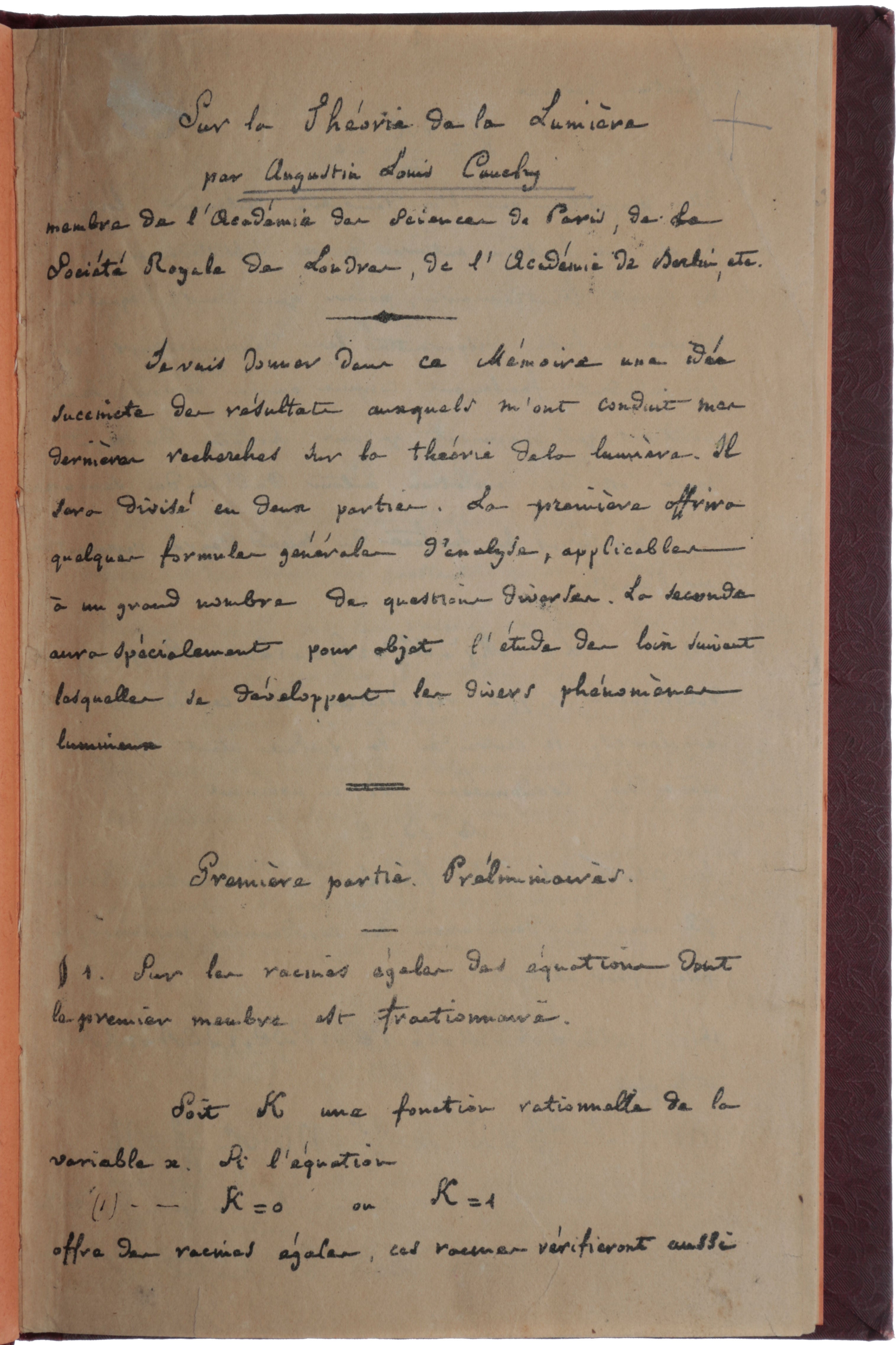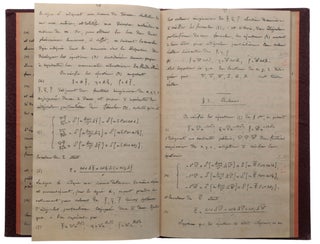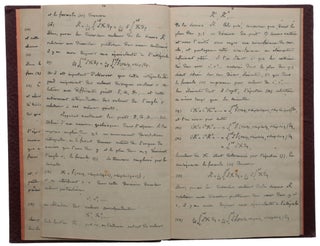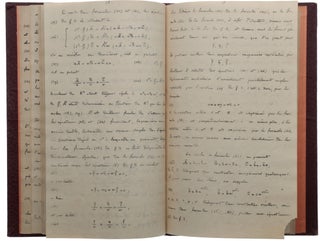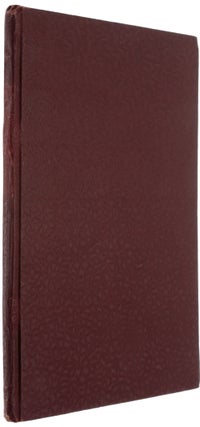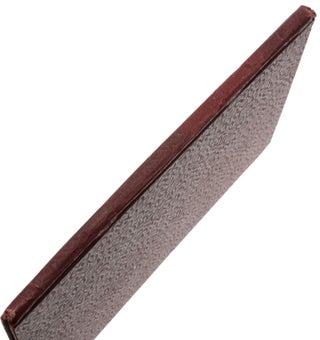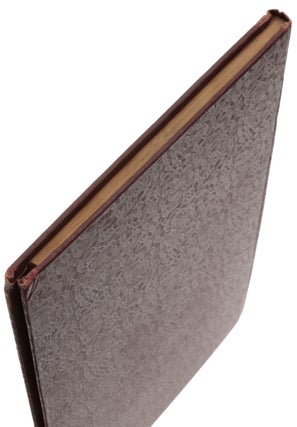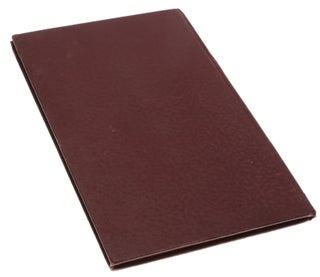Sur la théorie de la lumière. Lithograph document reproduced from Cauchy’s autograph manuscript.
[Budweis, or Prague?]: N.p., August 1836. First edition, exceptionally rare. “As early as August 1836 Cauchy had a memoire ‘Sur la théorie de la lumière’ lithographed in Budweis [now in the Czech Republic], which contains the main features of the whole of today’s theory” (Grailich, p. 74, note, our translation). This is “a 96-page lithographed publication on light, dated August, which is very rare and not in his Works: a German translation/edition appeared in 1842. After stating various results in pure mathematics, including the expressibility of sums as integrals, [Cauchy] ran through equations and solutions for the propagation of light in various kinds of media. Among his notations, he used some exotic operator symbols to denote differentiation and related techniques” (Grattan-Guinness, p. 1246). “From 1830, the central problem in optics was to determine the mechanical quantities comprising the light medium. For example, in order to explain light polarization, Fresnel supposed that the vibrations producing light consisted of both longitudinal and transverse vibrations; in polarized light, longitudinal ones are missing. But this meant that transverse waves had to travel through a fluid medium, which was impossible, as S. D. Poisson, another Laplacian, pointed out. Fresnel responded to this objection with the hypothesis that the ether was rigid. A rigid ether was susceptible to mechanical modeling; one could construct it in pieces. By contrast, A. L. Cauchy pursued a thesis that assumed an ether with the properties of an elastic solid, but the mechanical structure of this elastic solid ether was open to question. Despite its immense difficulties, Cauchy's theory allowed for the use of differential equations in the description of wave phenomena. This approach appealed to British physicists such as John Herschel, G. B. Airy, W. Whewell, and especially George Green, because it dispensed with the need to explicitly model and define the material microstructure of the light medium” (Victorian Web). “During the 1830s, optical theory became for a time nearly synonymous with Cauchy’s ether dynamics” (Buchwald, p. 461). Cauchy’s monograph appeared during his self-imposed eight-year exile from France following the July Revolution of 1830, which deposed the reigning Bourbon monarch, Charles X, and forced him to flee the country. For part of this time Cauchy served the exiled Bourbon court as science tutor to Charles X’s grandson, and his court duties prevented him from publishing as frequently as he had prior to leaving France. On page 94 of his monograph, Cauchy reports that “circumstances independent of my will”—probably something to do with the court— “oblig[e] me to interrupt the execution of my project” (Grattan-Guinness, ibid.). There are probably 15-20 lithographed articles by Cauchy, but they are all extremely rare and hardly ever appear on the market. Hans Freudenthal states in DSB that he knows of only two of them. Belhoste (p. 279, n. 29) states that the present lithograph “is not widely known, [and] is not contained in the Oeuvres Complètes.” Grattan-Guinness (ibid., p. 1447) states further that the book is “rare” and refers to a copy at the Royal Society in London. Grattan-Guinness gives the place of publication as Prague; Grailich gives it as Budweis. OCLC lists only four copies worldwide—Staatsbibliothek Berlin, Huntington, Harvard and Oxford. No copies in auction records. On June 7 and 14, 1830, Cauchy presented a comparatively short (given his customary standards) memoir on light before the Académie in Paris, entitled Mémoire sur la théorie de la lumière. He then left the city in the first week of September, probably not at first intending to go into exile but rather to rest after the, to him, dispiriting events of the July revolution and following his exhaustingly extensive record of publication and presentation of memoirs. His absence turned into a true exile, taking Cauchy at first to Fribourg, then Turin, and eventually to Prague in 1833. Over the next five years Cauchy followed the exiled king’s migratory court, spending 1835 in Hradshin and Toeplitz, 1836 in Budweis, Kirchberg and Goeritz, and the early part of 1838 in Kirchberg. Cut off from Paris, Cauchy was unable to publish the relatively little research he was able to carry out in the usual Paris journals. He therefore had some of his work during this period printed as mémoires détachées, often in lithographed form. In the early 1820s Augustin-Jean Fresnel developed a mechanical theory of the ether, the all-pervasive medium through which light was believed to propagate. It was a system of point masses that exert central, repulsive forces upon one another. “In 1823 Fresnel advanced a qualitative explanation of dispersion, based on ether dynamics, that became immensely influential in the 1830s, particularly for Cauchy. Dispersion, according to Fresnel, depended on the spacing and forces between the mutually repelling particles of the ether. The clear implication of Fresnel’s remarks was that theory had to address these two factors (spacing and force) in order to deal quantitatively with dispersion. This was precisely what Cauchy had begun to analyse, in a different context, in 1827, the very year that Fresnel died … “Cauchy’s early ether dynamics dates to 1830. By that time he was well prepared to see the possibilities in Fresnel’s suggestions, and in particular immediately to correct the great lacuna in Fresnel’s dynamics: namely the assumption that the ether lattice remains essentially rigid even when one of its elements is displaced. Assuming only that the displacement is small in comparison with the distance between the points, Cauchy was able to generate a differential equation in finite differences for the motion of an arbitrary lattice element as a function of the differences between its displacement and that of every other element of the lattice. The equation became so common in optics articles and texts during the ensuing decade that it should be called canonical. To produce from these intricate expressions a theory of dispersion whose constants reflected ether properties was no easy task, as the almost impenetrable mound of computations and approximations that Cauchy eventually published in 1836 would seem to show. In essence, Cauchy first imposed symmetry conditions on the lattice and then calculated the differences in the displacements by means of a Fourier series. After a very great deal of tedious work these elephantine calculations birthed … a series for the refractive index that has since become known eponymously as ‘Cauchy’s series’ … the series did seem to work empirically … there can be no doubt that many of Cauchy’s contemporaries, including William Rowan Hamilton, were deeply impressed by his ability to obtain a dispersion formula. Articles on Cauchy’s theory poured forth, particularly in Britain, and a very great deal of thought was devoted to it” (Buchwald 2012, pp. 460-462). “The essentials of the structure that Cauchy had begun to develop after Fresnel’s death and that he used to produce a dispersion formula are deceptively simple. Imagine an arrangement of point like particles each of which acts on all of the others with a repulsive force. We do not initially make any assumptions about the arrangements of the particles, in particular what symmetries the system might obey, and neither do we specify the form of the force other than to assume that it falls off with distance. Through their interactions these particles establish a pattern that results in wave propagation, and Cauchy aimed rigorously to analyze the system in order to generate optical equations. Each particle in the system acts to produce an acceleration on every other one that is directed along the line joining each pair, that depends on their masses and on their mutual distance, and that, like gravity, satisfies Newton’s third law. The system has an equilibrium configuration in which the net force on every particle vanishes, thereby providing Cauchy with a first condition that the constants of the system must satisfy … Cauchy over time rang several changes … In all cases he recurred to what are, in modern terms, eigenvalue techniques in order to obtain expressions for propagation. He was in this way able to obtain a reasonably close approximation of Fresnel’s wave surface for biaxial crystals, the crowning glory of the latter’s optical theory. And Cauchy obtained as well what he implicitly claimed to be his own expression for dispersion, one that soon generated considerable discussion, particularly in England. In order to reach tractable equations that would lead to a dispersion formula, Cauchy first imposed central symmetry on his system of particles, followed by complete isotropy. In an extraordinarily intricate analysis running to many pages and equations, he thereby demonstrated that the rate of propagation for a given wavelength in the medium, can be expressed as an infinite series in the reciprocals of the wavelength’s even powers” (Buchwald 2012, pp. 406-7). “In August 1836, just before his departure for Goeritz and hard on the heels of his study on dispersion [Mémoire sur la Dispersion de la Lumière, Prague, 1835-6], Cauchy had a lithograph of another of his works published. Entitled Sur la théorie de la lumière, this study was an extract of the materials from his notebooks of 1836. “The first part of this study was devoted to some mathematical preliminaries. In particular, Cauchy examined a new method for determining the boundary conditions for a body regarded as a system of molecules. The remaining sections treated various questions concerning the theory of light. Cauchy developed a new method for transforming the equation of motion of a system of molecules. Instead of representing the displacements [of the individual molecules] by Fourier series expansions, as in 1830, he used Taylor’s series … Cauchy also established the general equations of motion for a uniaxial system of molecules. Finally, he investigated the propagation of plane waves in isotropic and uniaxial systems of molecules” (Belhoste, pp. 170-1). The present work was translated into German by Franz Xaver Moth (Über die Theorie des Lichtes, Vienna: Gerold, 1842). The review of that work published in Archiv der Mathematik und Physik (Bd. 2 (1842), p. 133) stated (our translation): “Professor Moth has earned special merit by translating this lithographed memoir by Cauchy, which is only available in very few copies, and which has until now remained completely unknown to many mathematicians and physicists. This memoir contains a brief account of the general equations which form the basis of all investigations into the particular phenomena of light, and gives a brief summary of Cauchy’s methods and results in his investigations into the theory of light.” Belhoste, Augustin-Louis Cauchy, 1991. Buchwald, ‘Optics in the nineteenth century,’ in The Oxford Handbook of the History of Physics (Buchwald & Fox, eds.), 2013. Buchwald, ‘Cauchy’s theory of dispersion anticipated by Fresnel,’ Ch. 22 in: A Master of Science History: Essays in Honor of Charles Coulston Gillispie, 2012. Grailich, ‘Brechung und Reflexion des Lichts an Zwillingsflachen optisch einaxiger Krystalle,’ Denkschriften der Kaiserlichen Akademie der Wissenschaften. Mathematisch-naturwissenschaftlichen Classe, Bd. IX, Zweite Abtheilung (1855), pp. 57-120. Grattan-Guiness, Convolutions in French Mathematics 1800-1899, vol. II, 1990.
8vo (213 x 133 mm), pp. 96 (margins trimmed affecting some page numbers, a few small lacunae at gutter margin of first leaf not affecting text, some marginal pencil annotations). Nineteenth-century cloth, slightly worn (ownership stamp on front free endpaper). Very good.
Item #5311
Price: $2,000.00

